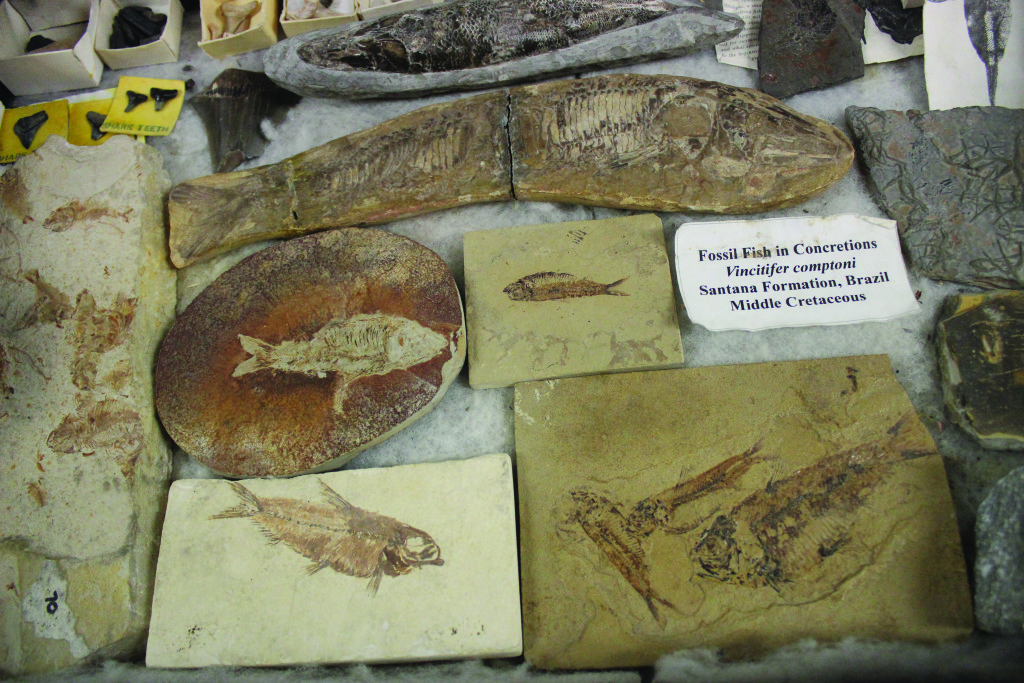|
This page was exported from Bancroft this Week
[ https://www.bancroftthisweek.com ] Export date: Thu Apr 3 16:46:06 2025 / +0000 GMT |
The Fossil Guy leaves rockhounds inspired By Nate Smelle The Fossil Guy, Bob O'Donnell wrapped up his compelling series of workshops at the 52nd annual Rockhound Gemboree on Saturday, Aug. 1 at the Bancroft Curling Club in front of a standing room only crowd. Eager to learn about the exciting and enlightening world of fossils people from all over North America shuffled into the room even after the presentation had begun to be a part of the hands on history lesson O'Donnell was teaching. Unlike many collectors O'Donnell encourages his audience to take a close look at, and even touch his fossil collection. By allowing children and adults to experience the fossils in this way it helps to create a stronger connection between his audience and the prehistoric world. Hoping to inspire younger generations to take an interest in fossils and science, he has taken his collection on the road; setting up his exhibit and sharing his knowledge with people from all over the world for the last 34 years. Residing near London, Ontario, O'Donnell says he enjoys looking for fossils at a couple of popular sites in South Western Ontario. The Rock Glen Conservation Area is one of his favourite places to search for fossils. There he serves as the museum steward of the Arkona Lions Museum and Information Centre. O'Donnell started his presentation explaining how palaeontologists classify fossils as any specimen that is more than 10,000 years old. Specimens that are younger than that he said are called sub fossils. He then went on to describe the many different ways organic matter can become fossilized. According to O'Donnell, since life forms can be preserved in mud, clay, tar, volcanic ash and even ice; when trees, leaves, ammonites, fish, turtles or anything else dies, it usually ends up lying down on the ground. As the organism is completely covered over by sediment of one type or another, minerals the size of a grain of sand will soak into the organic matter gradually replacing it as it rots away. This process is called mineral replacement. “The whole thing is replaced all the way from the top right through to the other side,” O'Donnell says. “So if the fish had eaten another fish for dinner it would be fossilized inside of it as well. If you use acid on the top of it you can see that fish with inefficient afterwards. It's super cool.” As a natural record of the history of life on this planet, he believes that the information stored in fossils is incredibly important for people to study. O'Donnell gave the example of all of the lessons learned by the scientific community from the discovery of a Wooly Mammoth perfectly preserved in arctic ice. Walking the earth between 10,000 to 15,000 years ago they fell through the ice and were frozen solid. “These are the best fossil you can ever get is something like this, because it's like a woolly mammoth in an ice cube,” says O'Donnell. “Every detail is there for you to see. They can comb the fur and come up with little insects; they can comb the fur and see pieces of leaves, seeds and .all kinds of different things that are all over them. They go into the hooves as well right at the bottom of their feet, and they dig out pieces of plant life and all kinds of stuff to learn more about the environment that these guys came from.” Since the whole body of the creature was frozen, including the blood, some palaeontologists are trying to clone the Wooly Mammoth. Although O'Donnell admits that it would be cool to see this massive animal brought back from extinction, he believes it would be far too risky since they could inadvertently bring back a prehistoric disease along with it. If they were to successfully bring back this creature, he says it would then become a living fossil. Living fossils are species alive today that you can find as fossils such as the coelacanth or the snapping turtle. Usually found in sedimentary rock, fossils give us a chronological account of the evolution of life on earth. “Inside of these layers is like looking through the pages of a book on the history of time,” he says. “Every time we open up a new layer it shows us a picture of the past and it's really quite beautiful. You can actually see where the brachiopods, the coral, the trilobites and everything lived.” For more information on The Fossil Guy visit www.thefossilguy.co.nr.    
|
|
Post date: 2015-08-04 18:44:57 Post date GMT: 2015-08-04 22:44:57 Post modified date: 2015-08-04 18:44:57 Post modified date GMT: 2015-08-04 22:44:57 |
| Powered by [ Universal Post Manager ] plugin. HTML saving format developed by gVectors Team www.gVectors.com |